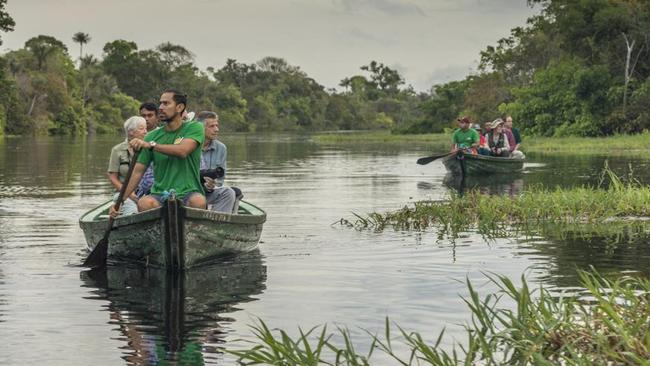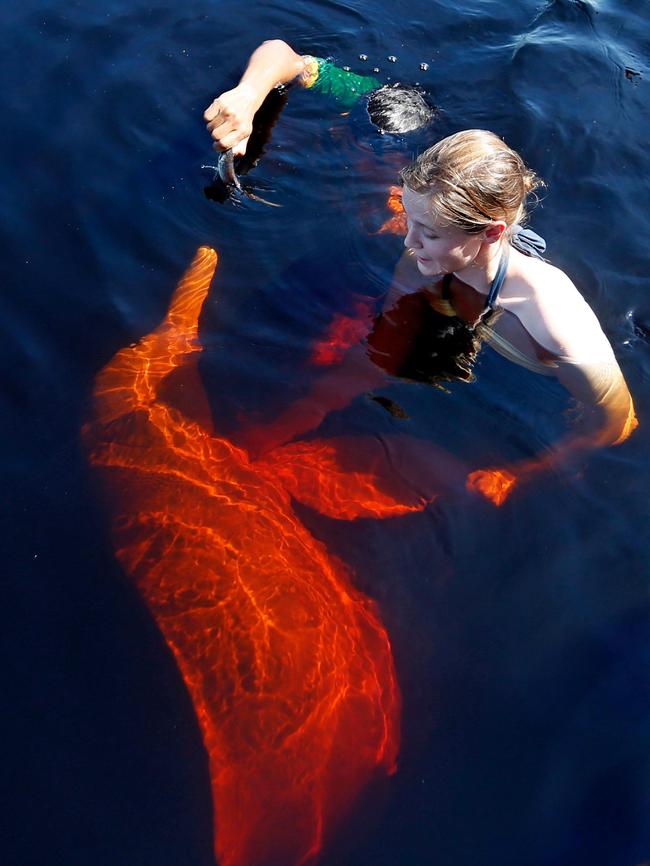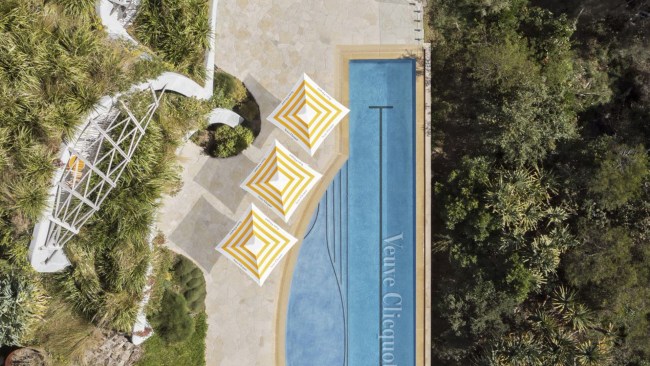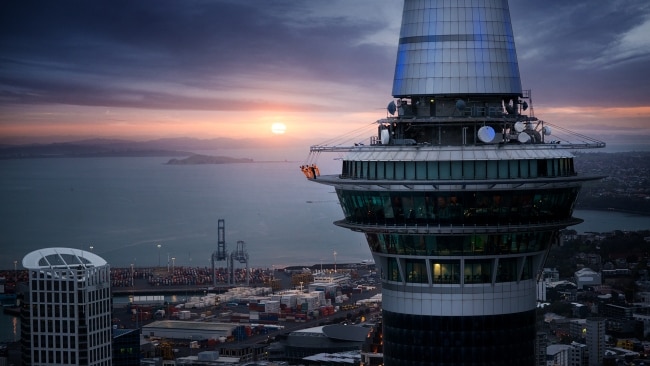Amazon River Naturetrek: ecotourism goes wild
Listen, learn and help save the wildlife with a 10-day Naturetrek Amazon voyage.

The mighty 6500km-long Amazon River is on the verge of spilling on to my lap. Water levels are the highest on record and as our dugout canoe, narrow as a carved toothpick, floats through a canopy of entwined treetops, I keep a watchful eye on the Coca-Cola-coloured water lapping at the rim of our boat. The canoe wood is etched with spear-tip scratches and pearly fish scales are scattered around my feet. My local guide and I are scanning the branches for signs of the hard-to-find golden-backed uakari monkey inside the remote Jau National Park.
We can hear their cackles up ahead, but are distracted by the sneezes of pink river dolphins as they surface beside us. It’s a side of the jungle that’s usually seen only by naturalists, and yet I have been in Brazil for just four days.
The Amazon. The name sells itself, but a cruise down the world’s longest river doesn’t always live up to expectations: dozens of touts gather on street corners in Manaus selling “jungle tours”, but most of the boats just sail up and down the middle of the 32km-wide river, far from the forest, and visitors leave disillusioned having only seen a few herons and monkeys. For those who venture deeper, sightings of the wildlife are highly unreliable.
How can you improve the odds when you’re searching an area as large as the lower 48 states of America? To find out, I have joined a new 10-day tour run by Naturetrek, which is pioneering a new approach.
Within 90 minutes of landing in Manaus I have one leg in the Rio Solimoes (pronounced Solly-moise) and the other in the Rio Negro. The “Meeting of the Waters” is a phenomenon where the silted Solimoes tributary joins the dark Rio Negro to form the Rio Amazonas. It’s like swimming between two streams of tea, one milky, one black. Indeed, the creamy Solimoes is 4C colder.

A clump of lily-pad roots floats past, reminding us there are creatures below. “You’re going to ask me about piranhas,” laughs zoologist Charles Munn, who has spent four decades studying the Amazon and, paddling nearby, has spotted the nervous look on my face. “I must have been swimming 4000 times and I’ve never been bitten — they’re most dangerous when you’re taking them off a fishing hook.”
But this paddle isn’t just for kicks: it’s an introduction to the Amazon’s biodiversity. “Animal density is 20 per cent higher in silted (fertile) waters like the Solimoes because fruiting trees have more nutrients to grow, and their fruit supports more species,” Munn says. He’s one of three naturalists joining us aboard Iracema, a wood-panelled beauty of a boat captained by Moacir “Mo” Fortes, a 60-plus Amazon veteran with a penchant for Hawaiian shirts. Taking pictures of us from above are our other guides: Portuguese zoologist Paulo Barreiros, British ecologist Lee Morgan and Brazilian guide Rafael Estrela, born and bred in Manaus. It’s an impressive pool of expertise, given that there are only 11 guests.
We chug upstream for a few hours and decamp, in the afternoon, into three small green boats Fortes has tethered to the stern of the Iracema. We paddle towards the trees and turn into our first igarape (canoe passage), eyes peeled. Almost immediately Estrela spots a three-toed sloth lounging in the upper arms of a tall tree. Farther on we see a green iguana, a canary-winged parakeet, a prehistoric hoatzin (a bit like a pheasant) with punk-rocker hairstyle, and in the background the ghoulish growls of howler monkeys echo across the forest. Night creeps as if a dimmer switch is turned.
Pavarotti wakes us at 5am. Skipper Fortes is playing his rousing rendition of Rigoletto loudly over the crackling speaker system. Within 30 minutes, we are all in the green boats and setting out to explore the biodiverse Anavilhanas Archipelago National Park, a hard-to-solve riddle of river channels and 400 islands that need expert navigation. All is silent save for the soft chirrup of insects and the gurgle and dribble of the paddle propelling our canoe through the narrow channels.
We pull in to take photographs of a group of white capuchin monkeys snacking on fruit in the trees’ lower limbs. As I stand up to take a picture, I notice a swirl of brown in the floating leaf litter. “An anaconda!” I yelp. It’s a baby at just 3m but the menacing eyes are unmistakeable. Guests cluster to take a look, but it writhes like twisted rope into the murky water. A few paddles more and we come across a hundred-strong band of squirrel monkeys, their bald heads and big eyes reminiscent of old men’s faces. They come right down next to the boat, one straining so hard to get a better look at us that it topples off its branch into the river.
Close encounters such as these aren’t a coincidence. Barreiros and Fortes have been working together to locate accessible populations of these species, knowing where they are likely to be during different seasons, and habituating them with pieces of banana to offer guests a “peak experience”. Like me, you may wince at the idea of changing animal behaviour in this way, but as Munn explains, “There’s a continuum, from pets and animals in zoos, to a wild animal in nature approaching you, to really wild species that are terrified of you. I’m willing to use any point on that continuum, except captivity, to promote forest conservation. I’d rather have the monkeys running wild, but realistically it’s no longer an option. We need to create valuable ‘nature fortresses’ that allow us to push back against the destruction.”
This behind-the-scenes research is beginning to be coupled with the use of camera traps along trails, so tourists can have good views of the nocturnal wildlife; evening lectures on the latest animal studies; and the use of non-intrusive drones to hover over pods of surfacing dolphins or fly alongside airborne macaws to give guests a bird’s-eye view of the rainforest. These techniques are not only setting a new standard for Amazon cruises, but position paying guests “at the tip of the conservation spear in the Amazon”, according to Munn. Their dollars are proof to the locals that the wildlife is of real value.

Another example is swimming with pink river dolphins. High up the Rio Solimoes, thousands of these boto are being slaughtered because their rotting flesh is the ideal bait for piracatinga, a species of catfish popular on Colombian plates. There are one or two simple outfits along the Rio Negro offering the chance to swim with the dolphins: simple floating decks where one or two fish are offered. “Is it responsible for tourists to get this close?” I ask Morgan. “We, particularly biologists, can be pious about interaction with animals, especially cetaceans,” he replies, “but we need to encourage interest in the species, so locals see the merit of protecting them; so they see that swimming with dolphins is more lucrative than killing them as fodder for catfish.”
There is still one creature that has eluded us, so as we navigate back through the Anavilhanas archipelago we keep our binoculars trained on the tree line. And then we see her. Perched in the afternoon sun on a tree rocketing above the canopy is a harpy eagle, the most powerful predator in the world. “Its claws are the same size as a grizzly bear’s, as thick as my wrist,” Barreiros demonstrates, gripping his arm, eyebrows raised excitedly. He’s just returned from a three-month recce to locate harpy eagle nests on behalf of Naturetrek using the drones. Mating pairs only raise one chick every three years, with the infant staying in the nest for a rather cheeky 22 months. Protecting them from deforestation is key.
The scientists’ arguments for a trade-off between conservation and making animals accessible to tourists are persuasive, but what’s important is not to let the details of the debate detract from what will keep visitors invested in the fate of the Amazon — experiencing it first-hand. We have to lower the binoculars, put the lens cap on the camera, and just look. It’s important to listen properly to the hum and roar of the jungle and absorb it completely.
That evening the river is still, the trees perfectly reflected in the water. Looking out across the endless stretch of tangled leaves, it strikes me that perhaps the Amazon should, and hopefully will, remain an enigma, a place of reflections, depths and mystery, despite all the research, the drones and the human interaction.
TELEGRAPH MEDIA GROUP



To join the conversation, please log in. Don't have an account? Register
Join the conversation, you are commenting as Logout